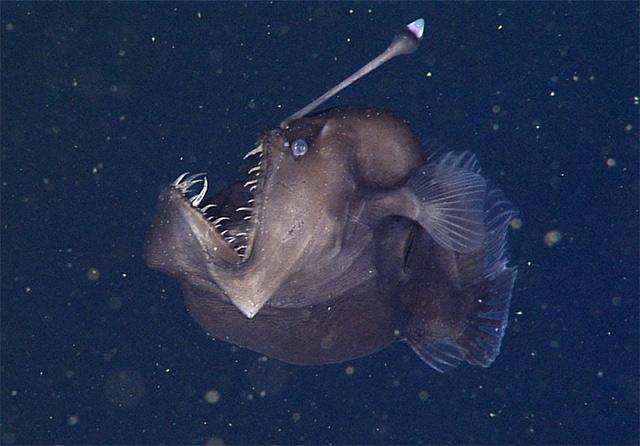Deep-sea anglerfish are strange and elusive creatures that are very rarely observed in their natural habitat.
Fewer than half a dozen have ever been captured on film or video by deep diving research vehicles.
This little angler, about 9 cm long, is named Melanocetus.
Fewer than half a dozen have ever been captured on film or video by deep diving research vehicles.
This little angler, about 9 cm long, is named Melanocetus.
It is also known as the Black Seadevil and it lives in the deep dark waters of the Monterey Canyon. MBARI's ROV Doc Ricketts observed this anglerfish for the first time at 600 m on a midwater research expedition in November 2014.
We believe that this is the first video footage ever made of this species alive and at depth.
We believe that this is the first video footage ever made of this species alive and at depth.
From CS Monitor
Those are the adjectives most humans use when describing the female angler fish, aka. the Black Seadevil.
But Monterey Bay Aquarium Research Institute (MBARI) senior scientist Bruce Robison offers a different perspective.
"Beauty is in the eye of the beholder," Robison told on Friday.
"I think it's beautiful. It's perfectly adapted to the habitat that it lives in and the kind of life it leads."
Anglerfish, like this Melanocetus, are among the most rarely seen of all deep-sea fishes.
At that depth, there's very little light.
But the female angler fish is equipped with a bioluminescent fishing pole to lure food near it's jagged-toothed mouth.
Fans of the animated movie "Finding Nemo" (2003) will recall that Dory and Marlin were drawn in by the glowing lightof an angler fish and almost became a meal.
As The Christian Science Monitor has reported, as MBARI scientists explore depths beyond 200 meters (660 feet), there's very little light in Monterey Canyon.
The work of the MBARI teams is explained in a new exhibit that opens this week at the Monterey Bay Aquarium.
As The Christian Science Monitor has reported, as MBARI scientists explore depths beyond 200 meters (660 feet), there's very little light in Monterey Canyon.
Many sea creatures that live at this depth are bioluminescent, which means they make their own light.
With their blinking blue and green lights, many of these gelatinous (jellylike) creatures in the deep ocean look more like spaceships than animals.
With their blinking blue and green lights, many of these gelatinous (jellylike) creatures in the deep ocean look more like spaceships than animals.
"When you see one, they really are more bizarre than science fiction could come up with," says Steve Haddock, marine biologist at the Monterey Bay Aquarium Research Institute (MBARI).
Blue-green light is the most common.
Blue-green light is the most common.
That is because these colors have a long wavelength in water and are easily spotted by sea creatures.
MBARI teams have only spotted just three Seadevils in 25 years of researching the underwater canyon off the California coast.
Research at these depths is conducted using remotely operated vehicles (ROV), and the latest MBARI explorer is dubbed the "Doc Ricketts."
The ROV is operated by scientists aboard the MBARI vessel, the R/V Western Flyer, a 117-foot small water-plane area twin hull (SWATH) oceanographic research vessel designed and constructed for this purpose.
MBARI teams have only spotted just three Seadevils in 25 years of researching the underwater canyon off the California coast.
Research at these depths is conducted using remotely operated vehicles (ROV), and the latest MBARI explorer is dubbed the "Doc Ricketts."
The ROV is operated by scientists aboard the MBARI vessel, the R/V Western Flyer, a 117-foot small water-plane area twin hull (SWATH) oceanographic research vessel designed and constructed for this purpose.
The work of the MBARI teams is explained in a new exhibit that opens this week at the Monterey Bay Aquarium.
The “Mission to the Deep” features a 360-degree video projection of the Monterey Canyon.
Links :
Links :
- National Geographic : Rare Black Sea Devil Caught on Film for the First Time







